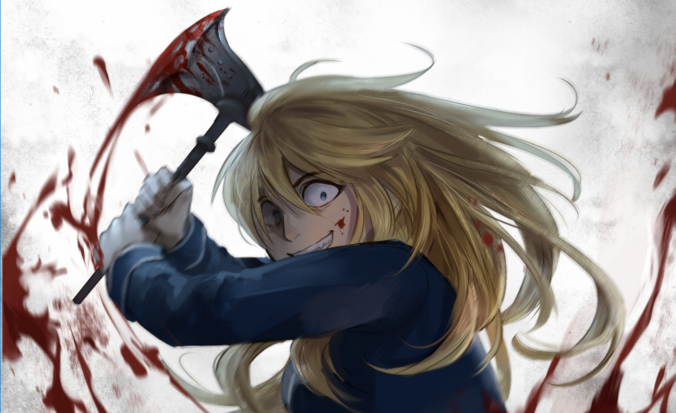
Crimson Gray
Crimson Gray represents the best and worst elements of mental instability within the yandere trope.
I’ve always found the yandere type of girl one of the more problematic tropes that you’ll see in media. Yandere refers to any girl with an unhealthy romantic obsession over a boy, often to the point of hyper jealousy, delusions of ownership and romantic entanglements with the boy, and violence (and it is always a girl, that’s worth pointing out). You know how a tsundere girl might make lunch for the story’s protagonist and insist that this doesn’t mean she likes him or anything, all while fidgeting shyly and blushing? A yandere would quietly watch that interaction from a distance, rush to steal an 18-wheeler from the closest truck stop parking lot she could access, and then use the stolen vehicle to run down the tsundere girl for daring to speak with her man. It’s obsession taken to horrific extremes which almost always ends in bloodshed.
By now you’ve probably started to put together why this trope is somewhat problematic. It’s an offshoot of the crazy girlfriend archetype by creating a character that almost invariably experiences an extreme and violent reaction to their boyfriend (or more often, their crush who could potentially be their boyfriend) speaking to any woman outside their blood relations. Yanderes are always gorgeous and usually display childish attitudes when not actively committing murder, playing into the hot crazy girl model. Their relationships with the object of their affection/obsession are decidedly unhealthy; the majority of the time the man in question is painfully aware that the yandere is mentally unbalanced and needs professional help, but ultimately chooses not to get her that help because he want to accept her the way she is or some such nonsense.
Yandere relationships are invariably toxic. The girl’s mental instability almost always ends with bloodshed, carrying on the dangerous (and frankly incorrect) notion that mental illness = immediate and severe physical danger to neurotypical people. The boy she pursues is usually experiencing some personal hardship at home or has trouble socializing with his peers, perhaps both, and inadvertently said or did something kind to the yandere in the past to kickstart her obsession. It makes the relationship predatory by nature and also subtly blames the victim for causing the girl to become their stalker in the first place. You know you’ve landed firmly in yandere territory where you’re watching a teenage boy apologize to his blood-soaked stalker for not being clearer about his affections before things got to this point. It’s a mess of insecurity entwining itself with instability until you have a codependent relationship that hinges on keeping the murderous half of the couple happy at all times. It’s incredibly uncomfortable to watch.
That said, Crimson Gray probably handled the yandere trope best by putting it in a story dense, choice-driven visual novel format.
Crimson Gray only takes a few hours to read through and complete all the varied endings, which works to its advantage because the VN absolutely expects you to replay it over and over again. You play as John, a high school student who is experiencing severe depression. At the start of Crimson Gray John has reached a point where often it’s an impossible struggle to simply climb out of bed. He sees the world as grayer than it used to be, has absolutely no support network to speak of (his so-called friends incessantly mock or tease him for feeling rundown) and his psychiatrist offers little help in the way of therapy and won’t listen to his insistence that the meds she’s put him on are actively making the depression worse. It’s probably one of the best portrayals of depression I’ve ever seen in any visual novel, and I’d likely tell you to buy Crimson Gray for that reason alone. The narrative does an excellent job establishing that John is in a very vulnerable mental state, more drifting through life than actually living it, even though he wants to get better. And then along comes Lizzie.
I need to be honest with you, I bought Crimson Gray on impulse because the store art was a blonde girl staring right into the camera with what I can only describe as crazy eyes. It was intriguing and a couple of bucks, so why not? Then I got five minutes into the VN and realized my singular love interest here was a full-blown yandere the likes of which I hadn’t seen since Mirai Nikki aired. Lizzie is a solitary and quiet girl who becomes obsessed with John after he defends her in front of some other students who call her weird (as plays into the trope). Lizzie begins stalking him, leaving notes in his locker and eventually managing to strike up a conversation with him and persuade him to take her on a date.
John reiterates over and over to himself (and the reader) how Lizzie’s behavior is very clearly abnormal and cause for concern. Normal people don’t have obsessions that are anywhere in the same ballpark as Lizzie’s fixation on him. The early chunks of their relationship in Crimson Gray give a distinct vibe that he is attempting to merely handle her more than sincerely return her affections. The initial moment he professes to like her in a possibly romantic sense comes immediately on the heels of her saving him from falling off the side of the building, when he realized that a fall on his part would have immediately be followed by a jump on hers. This is not a healthy dynamic.
Obviously the VN is going to have a possible happy ending where the two end up in love at the end, but good lord it is hard to get that ending. More likely than not you’re going to end up on the path of being held captive in her basement in the same room as her frightfully extensive knife collection, likely ending in either your death or a murder-suicide. It felt like Crimson Gray was trying to emphasize that there was an incredibly minute chance that you would come out of this in one piece, and even the “good ending” involved plenty of mental and physical trauma being inflicted on John and Lizzie. The story is disturbing and their dynamic is repulsive, a reminder that in all likelihood relationships like theirs are going to end with mental scars at the very least. You could have a happy ending, yes; but you’re not very likely to actually get it.
To his credit, John spends a good deal of the story trying to get Lizzie professional help. The exact year is never mentioned, but they’re in high school and Lizzie’s date of birth is stated as 1972, meaning that Crimson Gray has to be set in the mid to late 1980s. It’s heartwarming to see him trying to help her in this era. He clearly wants to be supportive and fix her, but doesn’t know what to do besides research medicines in library books or talk to a local pharmacist. Eventually they put her on a few weeks of antipsychotics, but tragically she stops taking them because they make her feel like someone else. Lizzie also explains to John that she’s the way she is because her mom took experimental medicine while pregnant (which I suppose makes yandere a birth defect in this world?). There’s a lot of background concerns about mental health treatment and pharmaceutical companies pushing medicine on people while ignoring negative side effects, not necessarily being anti-treatment but rather suggesting that there’s something to the notion that the same treatment won’t work for everyone. I’m disappointed that the takeaway is apparently letting a yandere remain an untreated maniac, but I appreciate the sentiment.
To me, yandere relationships are toxic and perpetuate dangerous false notions about mental illness. Frankly I’m happy that they seemed to have peeked with Yuno in Mirai Nikki and that the biggest yandere we’ve seen recently was in 2017’s Love Tyrant, a parody anime that lampooned yandere girls more than portrayed them as desirable. But if you really want to delve into the yandere type in a way that offers up the insanity you crave alongside a critical look at the mental health problems inherent to the trope, Crimson Gray is where I’d direct you.
Crimson Gray is available on Steam and itch. Solid recommendation from me.





